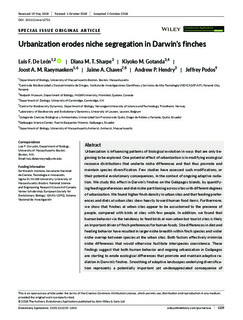| dc.contributor.author | De León, Luis Fernando | |
| dc.contributor.author | Sharpe, Diana, M.T. | |
| dc.contributor.author | Gotanda, Kiyoko | |
| dc.contributor.author | Raeymaekers, Joost A. M. | |
| dc.contributor.author | Chaves, Jaime A. | |
| dc.contributor.author | Hendry, Andrew P. | |
| dc.contributor.author | Podos, Jeffrey | |
| dc.date.accessioned | 2019-09-12T13:03:24Z | |
| dc.date.available | 2019-09-12T13:03:24Z | |
| dc.date.created | 2019-01-15T17:37:58Z | |
| dc.date.issued | 2018 | |
| dc.identifier.citation | Evolutionary Applications. 2018, . | nb_NO |
| dc.identifier.issn | 1752-4571 | |
| dc.identifier.uri | http://hdl.handle.net/11250/2616624 | |
| dc.description.abstract | Urbanization is influencing patterns of biological evolution in ways that are only beginning to be explored. One potential effect of urbanization is in modifying ecological resource distributions that underlie niche differences and that thus promote and maintain species diversification. Few studies have assessed such modifications, or their potential evolutionary consequences, in the context of ongoing adaptive radiation. We study this effect in Darwin's finches on the Galápagos Islands, by quantifying feeding preferences and diet niche partitioning across sites with different degrees of urbanization. We found higher finch density in urban sites and that feeding preferences and diets at urban sites skew heavily toward human food items. Furthermore, we show that finches at urban sites appear to be accustomed to the presence of people, compared with birds at sites with few people. In addition, we found that human behavior via the tendency to feed birds at non‐urban but tourist sites is likely an important driver of finch preferences for human foods. Site differences in diet and feeding behavior have resulted in larger niche breadth within finch species and wider niche overlap between species at the urban sites. Both factors effectively minimize niche differences that would otherwise facilitate interspecies coexistence. These findings suggest that both human behavior and ongoing urbanization in Galápagos are starting to erode ecological differences that promote and maintain adaptive radiation in Darwin's finches. Smoothing of adaptive landscapes underlying diversification represents a potentially important yet underappreciated consequence of urbanization. Overall, our findings accentuate the fragility of the initial stages of adaptive radiation in Darwin's finches and raise concerns about the fate of the Galápagos ecosystems in the face of increasing urbanization. | nb_NO |
| dc.language.iso | eng | nb_NO |
| dc.publisher | Wiley | nb_NO |
| dc.rights | Navngivelse 4.0 Internasjonal | * |
| dc.rights.uri | http://creativecommons.org/licenses/by/4.0/deed.no | * |
| dc.title | Urbanization erodes niche segregation in Darwin's finches | nb_NO |
| dc.type | Journal article | nb_NO |
| dc.type | Peer reviewed | nb_NO |
| dc.description.version | publishedVersion | nb_NO |
| dc.source.pagenumber | 15 | nb_NO |
| dc.source.journal | Evolutionary Applications | nb_NO |
| dc.identifier.doi | 10.1111/eva.12721 | |
| dc.identifier.cristin | 1657642 | |
| dc.description.localcode | © 2018 The Authors. Evolutionary Applications published by John Wiley & Sons Ltd This is an open access article under the terms of the Creative Commons Attribution License, which permits use, distribution and reproduction in any medium, provided the original work is properly cited. | nb_NO |
| cristin.unitcode | 194,66,10,0 | |
| cristin.unitname | Institutt for biologi | |
| cristin.ispublished | true | |
| cristin.fulltext | original | |
| cristin.qualitycode | 1 | |

